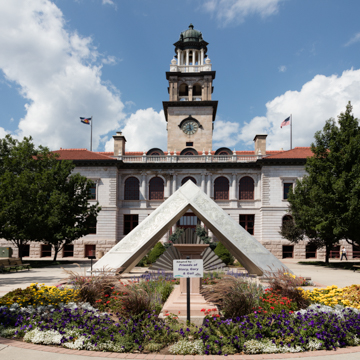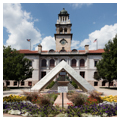You are here
Colorado Springs Pioneers Museum (El Paso County Courthouse)
Augustus Smith, according to Manley and Eleanor Ormes's 1933 Book of Colorado Springs, was “not only prodigal, but wanton in his use of forms, undoubtedly lacking discrimination with materials.” Despite such criticism and later demolition proposals, this $420,000, three-story palace survives on a spacious, landscaped block. The Renaissance Revival design on a U plan is muddled by an exotic entry portico and the awkward central clock tower rising three more stories to an ornate domed cupola, an element that anticipated a never-built fourth-story addition. Rough-cut blocks of Pikes Peak granite, a distinctive pinkish stone speckled with black mica, were used for the foundation. Rhyolite and cast stone were used for the upper levels. Hand-carved Indian heads—each one different—decorate the keystones of the first-floor window arches. Inside, scagliola columns of various orders rest on marble floors. Decorative painted ornament remains on the coffered ceilings, and murals of historical scenes adorn the walls. An Otis birdcage elevator remains in operation as an alternative to the wide stairways. A medical history exhibit on the second floor includes a Gardiner Sanitary Tent,
Writing Credits
If SAH Archipedia has been useful to you, please consider supporting it.
SAH Archipedia tells the story of the United States through its buildings, landscapes, and cities. This freely available resource empowers the public with authoritative knowledge that deepens their understanding and appreciation of the built environment. But the Society of Architectural Historians, which created SAH Archipedia with University of Virginia Press, needs your support to maintain the high-caliber research, writing, photography, cartography, editing, design, and programming that make SAH Archipedia a trusted online resource available to all who value the history of place, heritage tourism, and learning.




